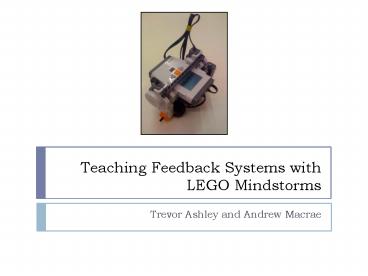Teaching Feedback Systems with LEGO Mindstorms - PowerPoint PPT Presentation
1 / 15
Title:
Teaching Feedback Systems with LEGO Mindstorms
Description:
Each lab should take approximately four hours to complete ... It must drive 10 feet to the finish. It must again balance for 5 seconds. Future Work ... – PowerPoint PPT presentation
Number of Views:178
Avg rating:3.0/5.0
Title: Teaching Feedback Systems with LEGO Mindstorms
1
Teaching Feedback Systems with LEGO Mindstorms
- Trevor Ashley and Andrew Macrae
2
Key Questions
- What are feedback systems?
- What are our goals?
- Summer 2008 What was accomplished?
- Fall 2008 Whats left?
3
Intro to Feedback Systems
- Open Loop System
- No connection from output to input
- Examples
- Plant RLC circuit Input Voltage Output
Current through inductor - Plant Rigid body Input Force on body Output
body displacement - Plant DC motor Input Voltage Output Torque
- Nearly all systems seen in E59/E101
4
Intro to Feedback Systems
- Closed Loop System
- Sensors measure output
- Error calculated by subtracting system output
from reference input - Controller used to alter behavior of entire
system - Typical Controllers Lead-Lag and PID
- Various methods exist for designing a controller
5
Intro to Feedback Systems
- Closed Loop Considerations
- Stability
- Does the entire system exhibit controllable
behavior? - Performance
- How well does the system follow given commands
(i.e. settling time, rise time and overshoot)? - Robustness
- How well does the dynamic system perform and
maintain stability given uncertainties (i.e.
plant modeling errors, sensor noise and outside
disturbances)? - These considerations affect how we design a
controller - and controller selection is the main topic of
E102!
6
Project Goals
- Write six hands-on labs for Spring 2008 E102
Course - Labs should emphasize concepts taught in E102
lectures - Students should be able to bring equipment to
their dorms and complete labs there - Each lab should take approximately four hours to
complete - Controller design and system simulation should be
emphasized programming (Java, C, etc.) should be
deemphasized - Have professors perform labs and provide comments
before Spring 2008 - Act as lab assistants for Spring 2008
- Write conference paper for the ASEE
7
Overview of Labs
- Students will
- Build a balancing robot (BOB) using LEGO
Mindstorms - Simulate BOBs dynamics using Simulink and MATLAB
- Upload their controllers from Simulink to the NXT
8
Lab 1 Introduction to Simulink
- Lab Objectives
- Build the LEGO cart
- Check that MATLAB has the required toolboxes
(Simulink, Realtime Workshop, Realtime Workshop
Embedded Coder, Control Systems) - Install the required third party software
(Cygwin, Gnuarm, and the ECRobot block diagrams,
LIBUSB) - Install a third party firmware onto the NXT (NXT
OSEK) - Learn Simulink by building and simulating a
continuous time, second order model of a
pendulum. - Build and simulate a discrete time and discrete
valued Simulink model of a controller that drives
the LEGO carts wheels forward 3 rotations. - Download the controller to the Mindstorms NXT and
test it
9
Lab 2 Stationary Robot Control
- Lab Objectives
- Attach a pair of beams to the wheels of the cart
- Explain the utility of each element of a PID
system - Add each element of a PID to a simulated
controller, observing their effects - Download the controller to the NXT
- Set up Bluetooth in order to make a plot of the
real arms performance - Test the arm and compare its performance to
simulation - Remove the beams so that cart can be used in
subsequent labs
10
Lab 3 System ID of Balancing Robot
- Lab Objectives
- Derive the governing equations of the balancing
robot model and a brushed DC motor - Experimentally determine parameters used in the
model - DC motor armature resistance, inductance, rotor
moment of inertia, coefficient of viscous
friction, back emf constant and torque constant - Robot mass and moment of inertia
11
Lab 4 Classical Control of Balancing Robot
- Lab Objectives
- Detach the beams from the robots base
- Use classical feedback control design (root locus
and Bode diagrams) to design a controller that
stabilizes only the pendulums tilt - Upload controller to the NXT
- Observe performance
12
Lab 5 Modern Control of Balancing Robot
- Lab Objectives
- Use modern feedback control design (full-state
feedback and pole placement) to design a
controller that stabilizes both tilt and wheel - Upload controller to the NXT
- Observe performance and compare to the
classical method of controller design
13
Lab 6 Race!
- Lab Objectives
- The robot competes in an open ended time trial in
which robust control in previous steps will
enable the robot to move faster - Race has three portions
- After start button is pressed the robot must
balance at the start line for 5 seconds - It must drive 10 feet to the finish
- It must again balance for 5 seconds.
14
Future Work
- Check legacy code for compatibility with MATLAB
2008a - Apply for Strategic Visions funding by September
29 - Complete lab drafts by October 16
- Order classroom LEGO sets by November 13
- Final drafts of labs due by November 20
- Lab assistants during 2009 Semester
- Write conference paper for 2010 ASEE Conference
and/or 2010 ACC
15
Questions?































